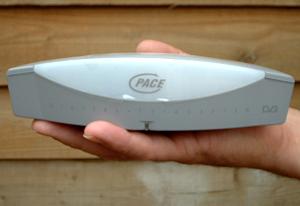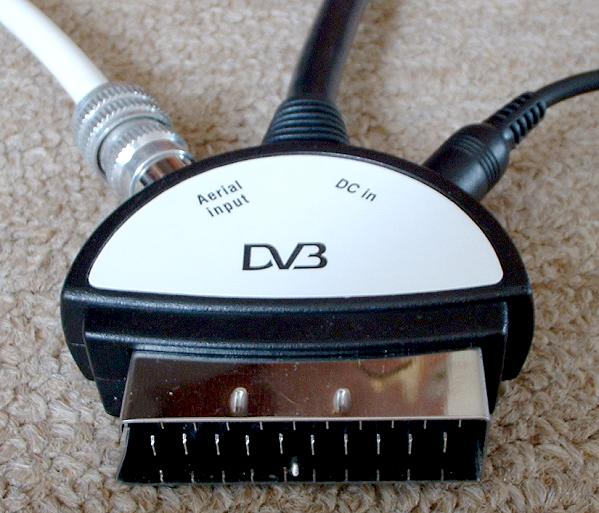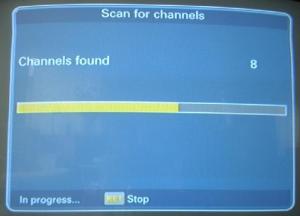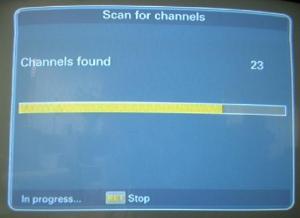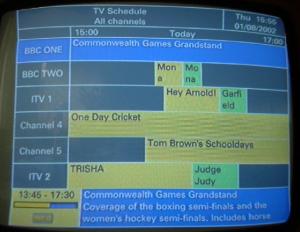|
||||||||||||||
|
Introduction In the past couple of months, the company which ran the subscription-only part of DTT has ceased trading. Times were hard and the majority of UK households are not in favor of subscription channels. Even the take-up of the most successful subscription delivery, namely satellite, is far outnumbered by the non-subscription households. So, for the foreseeable future, the DTT system will carry OTA channels. To this end, the licenses for the old subscription channels have been taken up by a consortium headed by the BBC and due to launch a total of about 24 channels around September, 2002. To make the DTT system more
robust in some of the marginal reception areas, an increase in transmitter
power and an improvement in the error-protection has been announced. This
latter move necessitates a reduction in the number of channels as part of
the trade-off between quality and quantity. Eventually, the intention is to
shut down the analog network to free-up bandwidth and reduce the fuel
consumption of the overall broadcast network. TVs with integrated digital
decoders are available, but to avoid the obsolescence of installed base of
analog TVs, inexpensive adapters are needed. The least expensive unit announced so far
is the subject of the remainder of this review, the Pace Digital TV Adapter
(DTVA). Nokia, Netgem, and Daewoo have also announced their own adapters. It's tiny! From the photo you can see it in the palm of my hand. And no, my hands aren't any larger than the average. Clearly, Pace has used the latest generation of chips to get the size down, though there has also been some reduction in functionality compared with earlier generations of Set Top Box (STB) digital adapters. The small size of the DTVA allows the unit to sit unobtrusively on top of the TV, even if the top falls away quite steeply like many modern designs. It could sit among the VHS tapes with the VCR or even be taped to the side of the TV. The only real restriction is the 1 meter length umbilical that connects the DTVA to the TV via the latter's SCART connector (photo below). Happily, all the connections to the DTVA are made via the 'enhanced' SCART - the TV, the aerial input and the power input.
The comprehensive manual illustrates 4 connection methods, depending on the SCART connections on associated equipment. Mine was slightly different in that the main TV has an EIAJ A-V connector rather than a SCART, so the SCART on the VCR was used. Having connected up the aerial, plugged in the plug-top power supply and switched on, the opening menu on-screen is a language choice - English or one of the UK's minority languages. The DTVA has no controls, so selection is done with the remote. Then the unit goes searching for channels. (see photos below). After about 2 minutes, they are all identified, and that's it, ready to use. The instructions warn not to switch mains power onto the power supply before connecting the DTVA. This is a sensible precaution since the supply is unregulated, and the inrush surge could damage the electronics.
The aerial connection is unlike
most set-top boxes - there is no (active or passive) loop-though. So the
DTVA expects to be at the end of any UHF chain, just like a TV. However, the
DTVA would normally be the most signal-critical device in the domestic
installation, so it would like to be 'first'. The Pace manual suggests the
solution to this is to use a Y connector/splitter, so the UHF aerial feed
is split between the DTVA and any other device (e.g., analog VCR) that needs
it. The signal reduction (3dB if you buy a decent splitter) should not
matter, notwithstanding the comments I made about signal strength being
marginal in my earlier article. I mentioned earlier that some functionality was missing, compared with earlier STBs. The chief one of these, I suppose, is the absence of a UHF output modulator. So connection to the VCR or TV needs to be via one of the three baseband modes: composite (PAL), RGB, or S-Video. In cutting down the cost of the unit, something had to go, and the cost and space saved helps to keep the outlay down. Trying out the DTVA with some of my legacy TVs threw up the need for a modulator for the kitchen set, so I pressed into service a Mitsubishi device originally intended to make one of their camcorders TV-friendly. Modulators are available cheaply, usually switchable for output to channel 2 or channel 3. The adapter can be configured to produce the correct geometry of picture for both 4 x 3 and widescreen TVs. It's a standard feature of these chipsets but essential for being 'inclusive' for as many existing TVs as possible. At some future stage in the evolution of DTT, there may be subscription or conditional-access (CA) programs once more. There is no slot in the DTVA to accept a 'viewing card' but underneath there is space for a CA upgrade. We are assured that this provision is all that is needed - the whole unit is software upgradable so this makes perfect sense. On the subject of software upgrades, the first unit I had (see later under 'Problems') requested a software upgrade which took a few minutes having accessed a BBC channel. Later software upgrades are expected for providing an improvement in the text-handling capabilities of the DTVA. The easy to use electronic program guide carries a clear graphical 'time-line' of outline information, provided the broadcasters have supplied the data to populate the guide. The information is program-specific, but you don't have to be tuned into any particular channel in order to gain information about the programs.
Under 'Technical Information'
in the menu system, there is a most comprehensive set of indicators. Various
MPEG parameters are displayed (only of interest to specialists such as
technicians monitoring all multiplexes at a transmitter site), but there is a
useful signal-strength measurement. This also shows the UHF-channel being
used and two measures of error-rate: corrected and uncorrected. This can be
used to clearly show how marginal or otherwise the reception conditions are.
They could be used for checking periodically how one's aerial installation
is weathering and to spot potential problems before they occur. These
on-screen meters operate in real-time rather than just taking a snap-shot
when you select them. This makes it easy to determine the effect of small
changes to the antenna installation. As mentioned earlier, there was a problem with the first DTVA I tried. All the normal start-up sequences ran according to plan, and then the unit asked for a software upgrade. That also ran perfectly well. Settling down to watch News24, however, showed the problem. After about 20 minutes, the DTVA suddenly claimed to be receiving 'No signal'. I checked to see that nothing had come adrift and tried other programs: all 'No signal'. So I switched off and decided to try later in the day. Re-trying gave me normal results; no software upgrade was requested, so that process had obviously worked OK. However, 20 minutes later, the fault recurred. This meant that I needed to return my DTVA and swap it for another. I wished I had noted down the serial number of the first unit but I didn't think of it at the time. Suffice to say, the second unit worked flawlessly from the start and didn't request a software upgrade. This makes me think that maybe the second unit was a later build than the first and that some internal improvement had been made between the two batches. A second issue hasn't
caused a problem yet, but I fear for my Front-Left and Front-Right
loudspeakers. There is quite a loud noise - somewhere between a click and a
thump - when the DTVA is powered-down into standby, and a less severe thump
when powered-up. It doesn't seem to be affected by the audio level from the
DTVA as selected by the remote control but is of course controlled by the
volume setting in the main amplifier. Being digital, the overall picture-quality is controlled by the bit-rate the broadcasters choose for the encoder. The decoded image (including the final Digital-to-Analog conversion) is at least as good as similar STBs I have seen from Philips and Nokia. Images are nice and stable, and there is no 'ringing' on text characters and other edges in the picture. The audio (also compressed using Musicam) is clear, undistorted, and without background noise. Selecting a program source which is off-air produces the same background noise level as when a program is muted - the minute amount of hum and hiss with the amp volume turned up must be due to the input stages of the amp rather than the DTVA. Stereo imaging appears to be accurate and stable, though the amount of material broadcast for controlled tests of this type is rather limited. I was greatly impressed by the response time of the DTVA when changing channels. Pace seem to have optimized this area of the design with the time to resolve a usable picture being brought down to the absolute minimum. With a typical MPEG-2 GoP (Group of Pictures) length of 12, one would expect to wait about half a second for the picture, but it seems shorter. Certainly noticeably less than for the two older STBs (Philips and Nokia) mentioned earlier. Pace and their chipset makers may well cleverly fast-track the first available I-frame received or (even more cleverly) bring B- and P- frames straight to the output. The power supply is molded onto the back of a standard UK 13 Amp mains plug. It gets warm to the touch but is designed for continuous operation - it would be unreasonable to have to unplug the power supply when not watching the TV. Besides, recording a digital program using the VCR's timer presumes the availability of content when the timer cuts in. The signal-strength available
in the main location in the house was suitable for all channels, provided the
aerial fed the DTVA alone. When used with a splitter, to share the signal
with the VCR, one of the multiplexes became too weak and error-prone. The
signal had dropped from 60% to 40%, and the 'uncorrected errors' count jumped
from zero to a high number, including 65,535 on occasions. The Pace DTVA is a very welcome addition to the equipment available to support the transition to digital broadcast TV over the next few years. For the large majority of viewers who have no desire to opt for a subscription TV service, the DTVA provides the ideal route to digital TV and increased choice, especially through its future-proof design. If an aerial upgrade is necessary, a reasonably unobtrusive roof-top aerial can be very easily fitted, unlike the situation with cable and satellite. In many cases a simple distribution amp can be used to extend UHF reception to every room that needs it. The DTVA itself is a fine unit.
Small and unobtrusive, smart and modern-looking, it deserves to be a success
in the marketplace and in British homes. Its functionality and performance
leave little to be desired - just the aerial loop-through and lack of
modulator are my only reservations. It is easy to install, own and use. The
price is OK for the next wave of interested viewers; an even lower
price-point should persuade an enormous number of households to convert.
With analog switch-off coming in the next few years, the scene is set for
a steady transition to digital, thanks in large part to availability of
units like the DTVA. - Graham
Vine -
|
||||||||||||||

